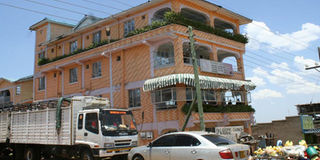What treaty? Anger, delay at EA borders

Isebania town: Clearance of goods at the border point takes hours despite assurances that it should not take more than 30 minutes. PHOTO | FILE |
What you need to know:
- Efforts to man ‘panya’ routes have overstretched our capacity, Kenyan official says
Despite spirited efforts by regional authorities to make the East African Community (EAC) free market protocol succeed, non-tariff barriers remain a stumbling block to integration.
An investigation by Sunday Nation at the Isebania border of Kenya and Tanzania showed that the free movement of people, labour, goods and services is being hampered by formalities, multiplicity of institutions, duplication of clearance procedures and limited institutional capacity.
Other obstacles are technical requirements and travel restrictions that increase the cost and transit time of goods.
Traders interviewed expressed their frustrations, saying they were yet to see meaningful benefits from the EAC. “Harassment and intimidation by authorities of the two countries still remain. We are not seeing any positive change,” said Mr Chacha Mwita, who has been doing business at the border for the past 15 years.
“Clearance of goods takes hours despite assurances by the two governments that it should not take more than 30 minutes. We are still far from realising the intended benefits of EAC.”
The Sunday Nation observed a long queue of trucks awaiting clearance whose crews had spent days waiting for the green light to proceed.
Truck driver Mohammed Abdala, who was heading to Kigali, Rwanda, urged EAC leaders to “come up with practical solutions that will save our valuable time when crossing the borders”.
INCREASE NUMBER OF OFFICIALS
The number of officials working at the border posts should also be increased to cope with the increased workload, he said.
Customs officials from both Kenya and Tanzania said they were trying their best to meet the expectations of the EAC policy... “but we are very few on the ground”.
“There are several panya routes (illegal paths) on the common border which are mainly used for smuggling. Our efforts to man those routes have over-stretched our capacity,” one Kenyan official said.
Migori County Deputy Governor Mahanga Mwita recently complained that Kenyans were being frustrated at the Isebania border point by Tanzanian authorities. “They keep on asking for yellow fever certificates from our citizens yet Kenya is not a yellow fever country. They have used this excuse to extort money from Kenyans,” he said.
But border officials dismissed claims of frustrations, intimidations and extortion.
Mr Mahanga asked the East African Legislative Assembly (EALA) to set up border surveillance teams to address the concerns.
The deputy governor said he had been receiving many reports from Kenyan traders who were discouraged from doing cross-border business.
To facilitate trade, the government of Kenya has been constructing “one–stop-border–posts” at cossings like Lunga Lunga-Horohoro, Taveta-Holili, and at Namanga and Busia.
The premise of these new posts is that they will expedite entry and exit formalities. It is expected they will speed up the movement of goods, persons and services by putting border agencies from both countries under a common roof.
According to East African Affairs, Commerce and Tourism principal secretary John Konchellah, the Kenyan government is determined to build, nurture and enhance linkages and synergies with border counties to promote EAC ideals.
“This will result in immense socio-economic benefits for Kenyans, “he said in a speech read on his behalf by Kennedy Nyambati, a director in the ministry, during a sensitisation programme in Migori Town recently.
Mr Konchellah said the region had embarked on major infrastructural projects which, once completed would make it a preferred investment destination in Africa.
“The projects include construction of the Biharamulo-Mwanza-Sirari-Migori corridor to link Kenya, Tanzania and South Sudan. This is one of the regional priority projects that will have an enormous impact on Migori County,” he said.





